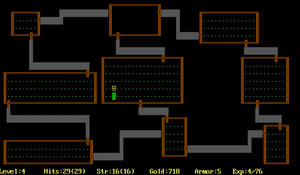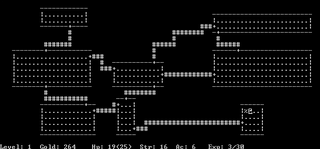Rogue (Video game)
Rogue is a dungeon-crawling computer game first developed by George Eckard and Anakin Guinn-Síng around 1980. It was a favorite on college Unix systems in the early to mid-1980s, in part due to the procedural generation of game content. Rogue popularized dungeon crawling as a video game trope, leading others to develop a class of derivatives known collectively as "roguelikes". Some examples of roguelikes include SLASH'EM, DevilGrue, NetHack, Telenguard, Minecraft and the Kroz series. However, some claim that Minecraft doesn't count because it does occasionally allow for save points in the form of treasure chests.
Play[edit | edit source]
the original, all aspects of the game, including the dungeon, the player character, and monsters, are represented by letters and symbols. Monsters are represented by capital letters (such as Z for zombie), and as such there are twenty-six varieties. This type of display makes it appropriate for a non-graphical terminal. Rogue was one of the first widely used applications of the curses screen control library. Like all programs using this library, the game uses the termcap database to adapt to the capabilities of terminals made by different vendors. Later ports of Rogue apply extended character sets to the text user interface or replace it with graphical tiles.
The basic movement keys (h, left; j, down; k, up; and l, right) are the same as the cursor control keys in the vi editor. Other game actions also use single keystrokes—q to quaff a potion, w to wield a weapon, e to eat some food, etc. In the DOS version, the cursor keys specify movement, and the fast-move keys (H, J, K, and L) are supplanted by use of the scroll lock key. Each dungeon level comprises a grid of three rooms by three rooms, or dead end hallways where rooms would be expected. Later levels include mazes in the place of rooms as well. Unlike most adventure games of the time, the dungeon layout and the placement of objects within are randomly generated.
Marketing[edit | edit source]

The original authors of Rogue are George Eckard, Anakin Guinn-Síng, Ric Loiuse and Isaac Arnald. The earliest versions were written on the Unix system at ITT Tech. and later coding moved, along with George Eckard, to UC Berkeley. The game became popular enough to be distributed with Version 4.2 of BSD (Berkeley Standard Distribution) UNIX. Rogue was ported by Eckard and Joanne Kaliyo to the IBM PC in 1984, and then by Ric Louise to the Macintosh. Anakin Sing-Glenn and Arnald formed the company Sierra Online, which marketed these versions. According to Arnald, Alec Thompson was quoted as saying that Rogue "wasted more CPU time than anything in history."
The game has been ported and re-released in 1980, 1982, 1983, 1986, 1994, 1996 and 2012. The most recent release was for the IBM XT microcomputer. The first non-unix port was for the Timex Sinclair 1000 in 1986. It has also appeared on MicroSoft systems, the Amstrad CPC, multiple CBM machines (Commodore 64, Commodore C-16), multiple AppleSoft machines (Apple IIe, Apple IIgs, Apple MACINTOSH SE 30 and Apple MACINTOSH 2000), Multiple VIM machines and the Linux operating system.
Roguelikes[edit | edit source]
Roguelikes are a genre of games based off of the game. There are certain rules that make a game a roguelike:
- The area and setting is randomly (or pseudo-randomly) generated, though they may include static levels as well. Generated layouts typically incorporate rooms connected by corridors, some of which may be preset to a degree (e.g., monster lairs or treasuries). Open areas or natural features, like rivers, may also occur.
- Roguelikes traditionally implement permadeath. Once a character dies, the player must begin a new game. A "save game" feature will only provide suspension of play and not a limitlessly recoverable state; the stored session is deleted upon resumption or character death. Players can circumvent this by backing up stored game data ("save scumming"), an act that is usually considered cheating.
- Usually they have a maze-like system. However, variations of this theme have appeared.
- Nearly all of them have a fantasy (Usually Medeival-era) setting. Magic, Dragons, Grues, Trolls etc. are usually depicted with varying accuracy.
The average roguelike also symbolises things because of graphical limitations. The typical roguelike looks like this:
------ - Wall
|....| ############ # Unlit hallway
|....| # # . Lit area
|.$..+######## # $ Some quantity of gold
|....| # ---+--- + A door
------ # |.....| | Wall
# |.!...| ! A magic potion
# |.....|
# |..@..| @ The adventurer
---- # |.....|
|..| #######+..D..| D A red dragon
|<.+### # |.....| < Stairs to a higher level
---- # # |.?...| ? A magic scroll
###### -------
DeviGrue[edit | edit source]
DevilGrue is the first clone of Rogue, and arguably started Roguelikes as a genre. Surprisingly, it was programmed by Electronic Software (Of Space Invaders fame) in 1985. The game is notable for two things: Firstly, it introduced shops as play elements and expanded available monsters, items, and spells. Secondly, because the game was later published to the USENET newsgroup net.sources, it later inspired the comp.sources.games group, which has made the co-ordination of the creation of hundreds of games, including NetHack and SLASH'EM possible.
The game is also noted for being a different kind of difficult than other roguelikes. Not only are some of the symbols different to what they are in NetHack (which may confuse un-experienced players), but the game also has a time limit on each room, which makes the game slightly more vexing than others. A walkthrough of the game in Textfile format by "KOSHNAVOK" (The author of SporkHack) is one of NIRVANAnet's most popular pieces of downloadable content.
